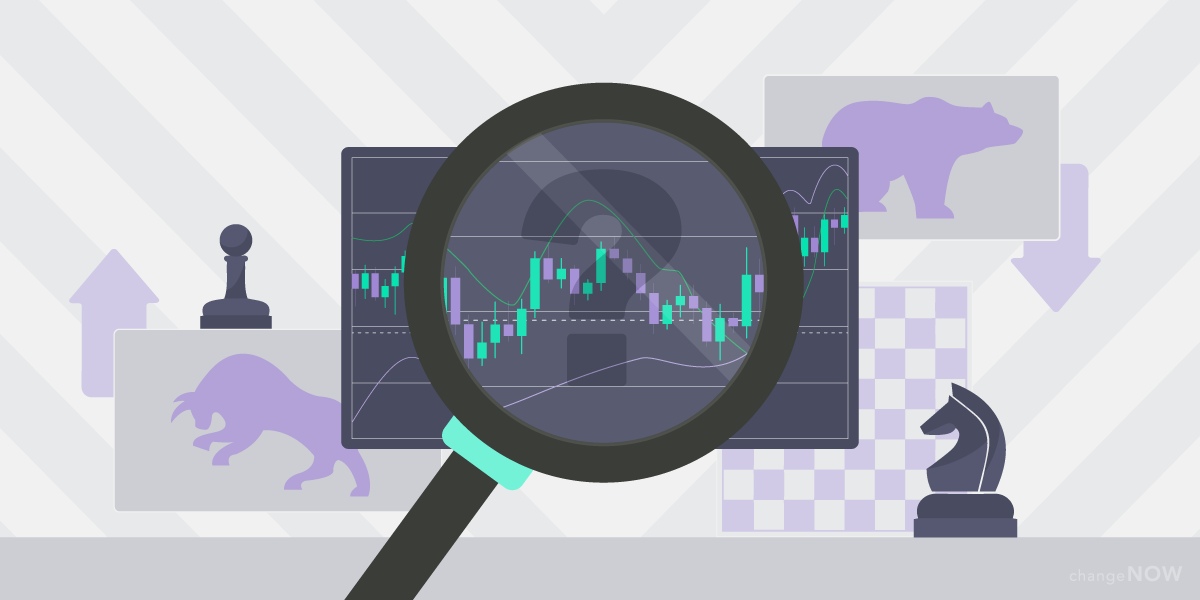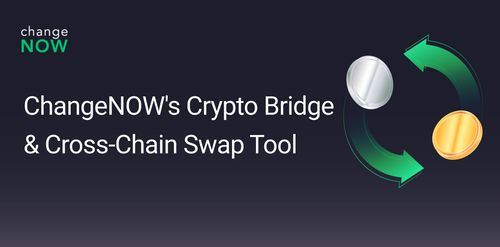Common Crypto Trading Strategies
That said, there are several ways to profit off of the crypto market. However, you need a trading strategy to combine those ways into a structure you can follow.
There are many crypto trading strategies out there. But before we go any further, there are two main schools of thought you need to understand before choosing or building your own trading strategy: Technical analysis and Fundamental analysis.

Technical Analysis, TA
Technical analysis, also known as charting, involves studying statistics, previous trends, and numerical changes in terms of price and volume fluctuations in a bid to predict future market behavior. Most traders use this as a tool for identifying trends and favorable trading opportunities.
At its core, TA is the study of traders' and investors' emotions (mainly fear and greed) through the relation of an asset's price to the opposing forces of demand and supply. In other words, the previous change in the price of an asset is a reflection of traders' emotions, which is an important factor in the cryptocurrency market.
While technical analysis is a useful tool, it is best suited to markets that operate within normal conditions (i.e., high volume and liquidity). This is because abnormal markets (low volume and liquidity) can be easily manipulated by external forces, resulting in false signals, hence rendering TA useless.
To carry out TA, traders use what we call technical analysis indicators. While there are numerous indicators out there, some of the most used ones include: Simple Moving Averages (SMA), Exponential Moving Averages (EMA), Relative Strength Index (RSI), Bollinger Bands (BB), Moving Average Convergence Divergence (MACD), etc.
Fundamental Analysis, FA
In addition to technical analysis, traders use fundamental analysis to help them make more accurate decisions beyond simple statistics by analyzing qualitative factors, such as market capitalization, company management, reputation, affiliations, etc. The goal of FA is to predict the psychological impact of the price of an asset. (.i.e., do traders think an asset is overvalued or undervalued?).
In fundamental analysis, predicting an asset's future price behavior involves more than its previous performance. It involves understanding the industry-specific market and considering the economic factors that may affect price behavior in that market.
On that note, FA seeks to determine how less tangible and qualitative factors, such as the ones above, affect the overall performance of a project.
Having discussed what technical and fundamental analysis are about, next up is a trading plan. Before we look at the common trading strategies, let's discuss what a trading plan should include.
Elements of Trading Strategies
A trading plan must include three main elements:
Market Entry and Exit Points
A mouse click on an order DOM or a call to a broker is all it takes to execute a trade, but knowing the right point to execute that trade is a rather technical affair.
Understanding the entry and exit points of a market is a crucial element of any trading strategy. You need to do your research. However, it is common practice to enter a market at its support level and exit at the next resistance level.
Risk Management
Most traders see effective risk management as the key to a successful trading plan. This is because risks are inevitable in the crypto market. However, with a risk management plan, you can assume full control over how much risk you take on a specific trade.
One way traders manage risk is by setting a stop-loss limit, a few units below the entry point or support level.
Psychology Trading
Most inexperienced traders often overlook psychology when building a trading plan. But to build a successful trading plan that would maximize profit, you need to adopt a strategy that suits your psychological makeup.
In other words, your trading plan must be user-friendly, understandable, and trusted by you (to promote discipline in its implementation).
Active Crypto Trading Strategies
As the name implies, active strategies require that you stay active within the market. That is, constantly studying charts, monitoring price behavior, and managing your portfolio.
Here are some of the most common active trading strategies:
Day Trading
Day trading involves making and closing an order within 24 hours, using hourly analysis as an aid to make decisions. This trading strategy is also referred to as high-risk trading because it often involves small price differences or large fluctuations. This can negatively affect investors that are prone to emotional trading.
For advanced traders who prefer to automate trading and direct all their strategies using trading bots, crypto day trading is perfect. There are numerous website options where you can find charts with hourly and daily data.
Arbitrage Trading
This trading strategy is common in the crypto trading industry due to characteristic large fluctuations on an hourly basis. There are numerous exchanges and trading centers, enough to provide investors the room to buy fast and sell even more quickly. This strategy's game plan is to accumulate small profits from several transactions within a day or an hour.
To achieve this game plan, you need to buy cheaply in one transaction and sell high on the other to make a quick profit. The upside of this strategy is that it reduces the risk of losses. But its downside is that you depend on the exchange rates on different platforms; this can make your efforts pointless if the exchange rates do not favor you.
Therefore, only use this strategy if you have everything in place. Also, you need substantial knowledge of the currencies you're trading as well as how to use a trading bot.
Swing Trading
The swing trading tactic leverages cryptocurrency graphs to point out trends within a certain period. The cryptocurrency market doesn't move in a straight line like the supply and demand chat we knew back in economics class. It moves in both directions (rise and fall). Swinging in the market refers to spotting a repeating price behavior over a specific period, then making decisions (buying or selling) to capitalize on the price behavior.
This tactic is common amongst experienced traders, those with strong knowledge of the market, and the ability to understand charts and indicators. Chart platforms or mobile apps are essential for this strategy. Understanding peaks and drops are imperative to making profits with this strategy.
Trend Trading
The trend trading strategy is much like the swing tactic, except with a slight twist. Where swing is to short-term trading, the trend is to long-term trading. You study major events behind a particular price behavior, but this time you're more interested in long-term changes as the aim is to spot substantial price differences.
This strategy has the potential to make more profits than swing trading tactics. However, it requires large investments, and you can suffer heavy losses for wrongly reading signs. And while swinging is suitable for experts, trend trading can accommodate starters as well.
Bear in mind that the cryptocurrency market is volatile, and prices can change abruptly. While this strategy can make you significant profits, you can lose your money quickly as well.
Scalping
Crypto scalping is similar to arbitrage trading. This strategy is based on the idea that smaller but numerous trades a day is the best tactic to make a profit. While this trading method can work on days where there are abrupt changes in the price, it should be used sparingly.
You can also indulge in this trading tactic if your goal is to make small profits while taking the lowest risks possible. It is great for starters to use this strategy for a trading test-run to get a feel of the market.
Passive Crypto Trading Strategies
Unlike with active strategies, you are allowed a more hands-off approach with passive trading strategies. In other words, constantly monitoring your portfolio is not a requirement.
HODL (Buy & Hold)
Buy and Hold in the crypto dictionary is known as HODL, which translates to hold on for your dear life in English. This strategy involves the trader looking to buy a cryptocurrency when the price is low and hold it until the market trends (buying and selling) take the price higher.
According to this strategy, the price will keep rising with time, meaning the more you wait, the larger your profit. But that isn't always the case.
This strategy has its merits and demerits. For the former, buying a coin and lending it out for profits is possible. You don't have to go through the hassle of complex daily analysis; instead, you concentrate on long-term indicators.
On the demerit side, you stand to suffer heavy losses if your long-term analysis goes wrong. For example, bitcoin rose to a whopping $20,000 in 2018, only to fall back to $4000 at the end of the year. But in the long run, HODL is a great strategy as evident in its rebound to an all time high of $62,000 in April 2021.
Note, for HODL strategy, you need a secure and trustworthy trading option.
Bottom Line
While trading cryptocurrency can be very lucrative, you need a robust trading strategy to ensure efficient use of capital in the face of a very volatile market. Study through the common strategies in this article, choose one that best suits you.
Note that it isn't compulsory to use one strategy forever, you can evolve as you gain more trading experience.
For whatever strategy, ensure consistency and strict adherence. If possible, create a trading journal to aid in analyzing your trading strategy. It is also advisable to use different strategies on different parts of your portfolio. This way you can measure different strategies’ performance to know which suits you best.



